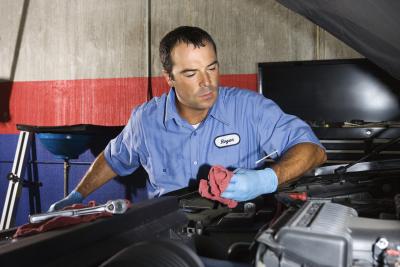
Unlike many modern engines, in which the camshaft rotates on top of the rocker arms to control the valves, the 351 instead features a single camshaft in the center of the engine block and a number of lifters and pushrods to actuate the valves. As the camshaft rotates, it pushes a lifter upwards. The lifter then causes a pushrod to rise and move the valve’s rocker arm. If the lifter is damaged, its valve will not function properly and an audible tapping sound will be heard. A damaged lifter should therefore be replaced as soon as possible.
Drain the radiator by rotating the petcock plug on the interior side of the bottom of the radiator in a counterclockwise fashion, with a wrench.
Loosen the clamp which secures the top radiator hose to the front of the intake manifold with a screwdriver and pull the hose off the intake manifold.
Loosen the clamp which secures the heater hose to the top of the intake manifold with a screwdriver and pull the hose off the intake manifold.
Loosen the bolt on the tip of the negative battery cable with a wrench and pull the battery cable off the battery.
Remove the four nuts which secure the base of the carburetor to the intake manifold with a wrench and lift the carburetor off the engine.
Remove the bolts which secure the intake manifold to the engine block with a wrench, then push the manifold towards the back of the engine until the front of the manifold clears the distributor. Lift the manifold off the engine to expose the pushrods and lifters.
Remove the valve cover’s securing bolts with a wrench and lift the valve cover off the cylinder head to access the rocker arms.
Turn the bolt in the center of the harmonic balancer in a clockwise direction with a deep-set socket wrench until the lifter reaches its lowest point within its bore.
Twist the adjustment nut in the center of the lifter’s rocker arm in a counterclockwise direction with a wrench only until the rocker arm can be rotated off of its pushrod, then withdraw the pushrod from the engine.
Grasp the wire insert in the center of the lifter with needle-nose pliers and pull the lifter out of the engine.
Apply a liberal amount of engine-assembly lube to the base of the new lifter, then lower the lifter into its bore.
Slide the lifter’s pushrod through its slot within the cylinder head and onto the top of the lifter.
Twist the pushrod’s rocker arm onto the tip of the pushrod.
Rotate the pushrod by hand while simultaneously tightening the adjusting nut in the center of the rocker arm with a wrench only until the pushrod can no longer be easily rotated, then tighten the adjusting nut an additional three-quarters of one turn.
Install the valve cover onto the top of the cylinder head with a new valve-cover gasket.
Install the intake manifold onto the top of the engine with new intake-manifold gaskets.
Position the carburetor onto the intake manifold, then install and tighten the carburetor’s securing nuts.
Tighten the negative battery cable onto the battery.
Position the heater hose onto its port on top of the intake manifold, then position the upper radiator hose onto the thermostat housing at the front of the manifold. Tighten each hose clamp with a screwdriver.
Pour a 50-50 mixture of water and new antifreeze into the radiator, then install the radiator cap.